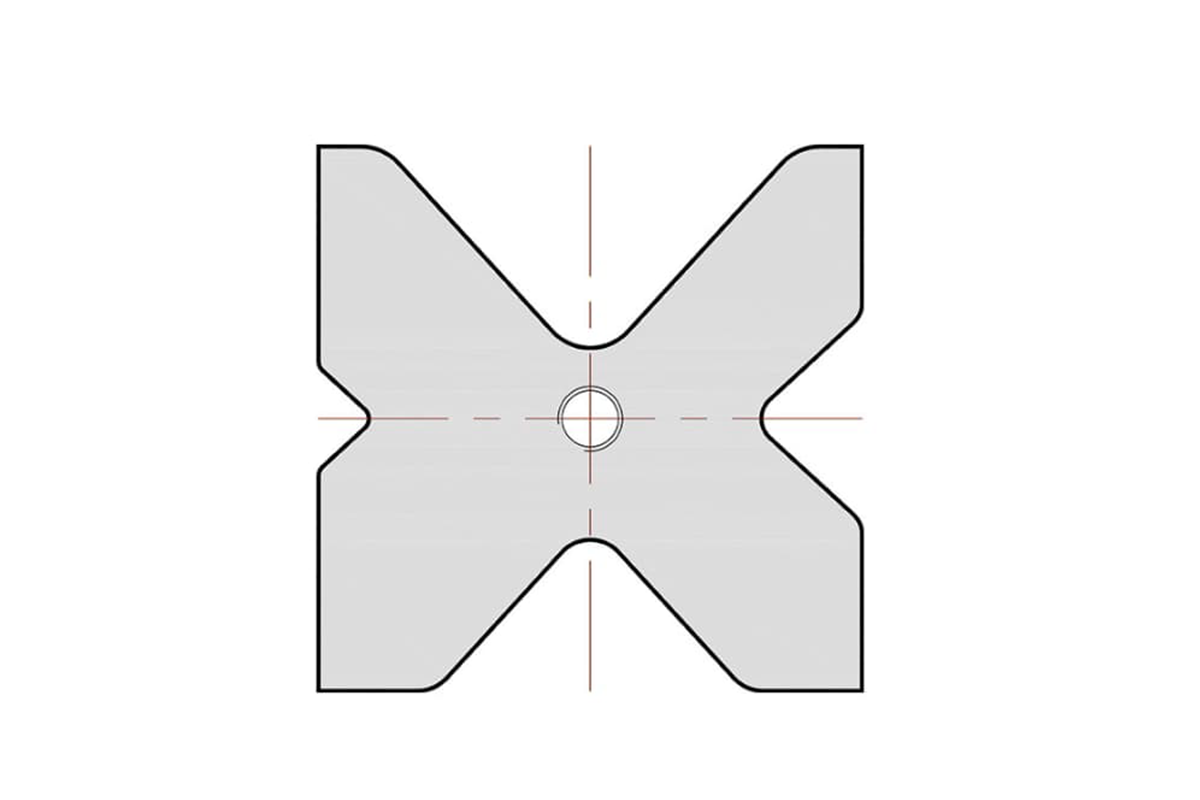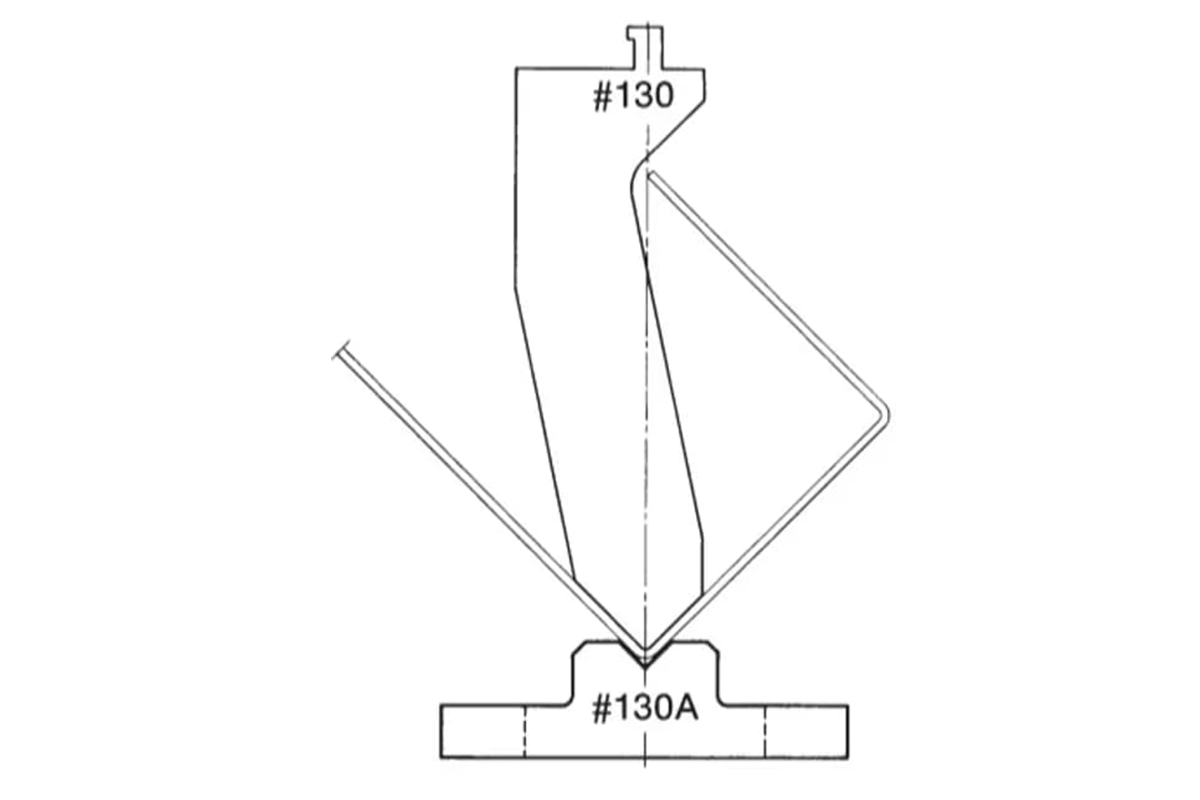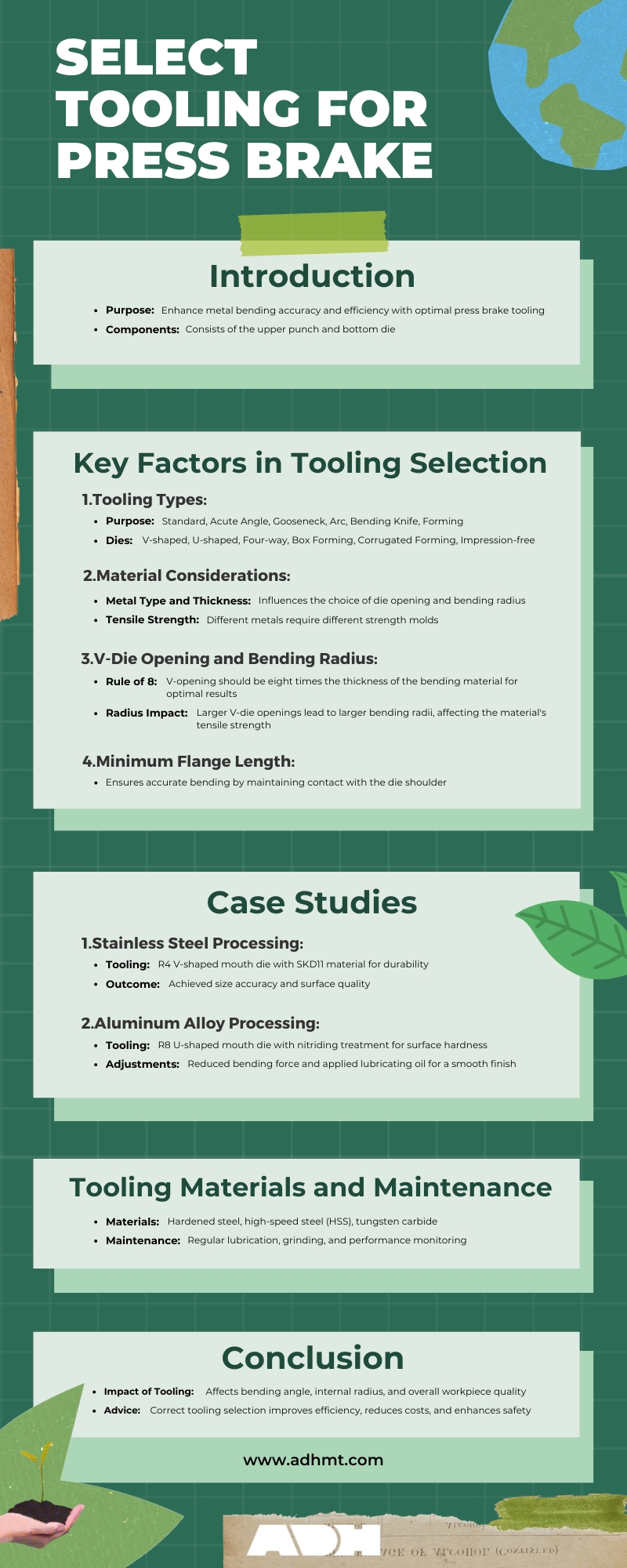I. Introduction
The press brake is an indispensable equipment in the metal processing industry, and the tooling is the "heart" of the press brake. The tooling of a press brake is divided into two parts.
The tooling installed at the top of the ram is called the upper punch, and the tooling installed at the bottom of the worktable is called the bottom die. The upper punch and bottom dies, two parts, work together on the metal sheet to complete the bending of the workpiece.
The process of the upper punch of the press brake applying force to the metal sheet on the bottom die is the bending process. The upper punch drives the ram to bend the metal sheet through different power sources. The driving sources include mechanical, hydraulic, servo motors, etc.
Choosing the right press brake tooling can not only improve processing accuracy and efficiency but also extend the service life of the die and equipment, reducing production costs. However, faced with a wide variety of press brake dies on the market, many users feel at a loss.
This article will start from the importance of selecting press brake toolings, analyze the key factors affecting the selection, as well as subsequent maintenance and care, to help you easily select the best press brake toolings.
II. Standards of Press Brake Toolings
There are different types of punches and dies, and selecting the correct matching punches and dies for bending is crucial to improve accuracy and efficiency.
Standard-size tooling is more convenient to replace, as the design of tooling parts with standard dimensions is consistent. This eliminates the need to make too many adjustments when replacing the punches and dies, as these toolings are kept in the same position for easy replacement.
The upper parts of the ram of the press brake require a clamping device for fixing the punches. Clamping fixes the punches in the required position, allowing them to bend the metal plate with the motion of the ram.
Die segmentation can facilitate the bending process of various-sized workpieces. Press brake toolings require very high accuracy, particularly the accuracy of punch tips and die shoulders, as these parts will directly contact the sheet metal during bending.
Punches and dies with high precision can reduce adjustments in the installation process.

III. Types of Punches and Dies
Press brake dies include V-die, U-die, and Z-die, with V-die being the most common. The minimum flange length should be at least 4 times the material thickness; otherwise, the exact bending angle cannot be obtained.
V-die sets with different opening widths match the corresponding punches, allowing the press brake to bend at different angles and materials. In this way, the press brake can bend at different angles and with different materials.
Press brake tooling is classified into 2 types: punch and die.
Punch types
- Standard Punch: The most commonly used punch type for general bending.
- Acute Angle Punch: Used for bending acute angles, generally between 25° to 60°.
- Gooseneck Punch: Used to avoid workpiece interference.
- Arc Punch: Used for bending arc shapes.
- Bending Knife Punch: Used to avoid multiple bends.
- Forming Punch: Used for one-time forming of complex shapes.

Die types
- V-shaped Die: The most common die, divided into single V, double V, and multi-V types.
- U-shaped Die: Used for U-shaped bending.
- Four-way Die: All four sides have grooves of different sizes.
- Box Forming Die: Used for bending box-shaped parts.
- Corrugated Forming Die: Used for forming corrugated workpieces.
- Impression-free Die: Includes ball bearing type, flap type, and polyurethane type, which can avoid bending marks.



IV. Consideration for Tooling Selection
1. Bending Material
The type of metal you want to bend is an important factor. The thickness of the metal determines the die opening, bending radius, and bending angle.
For example, some steels have greater strength and resistance than others, and this resistance is called the tensile strength (UTS) of the metal. The tensile strength of metals is different, which requires different strength molds.
In addition, the length of the metal plate determines how many toolings are required. Another factor is the thickness of the metal. Tools designed for sheet metal may not be suitable for thicker materials and may cause premature wear or damage to tools and press brakes.
2. V Opening and Radius of Material
When bending sheet metal, if the thickness and metal type are the same, there is not only one V-die opening size. The sheet metal must not be lost during bending.
If the internal radius is less than the thickness of the metal plate, the plate will be stretched, leading to workpiece deformation.
A radius greater than the thickness of the sheet will not cause deformation. When choosing the perfect V-die opening, we should not only avoid radius deformation but also choose a smaller radius.
3. The rule of 8
There is a rule of thumb applicable to the V-opening of press brake dies, known as the rule of 8. The rule of 8 is based on 60,000 PSI tensile cold-rolled steel and stipulates that the V-opening die shall be eight times the thickness of the bending material.
The rule of 8 applies to most bending processes. Within the specified tonnage range, an internal radius approximately equal to the thickness of the material can be produced.
However, this is not a perfect law, because the factor will increase or decrease with the variation of the material thickness. As a result, the width of some V-die openings is 6 times, 10 times, or even 12 times the thickness of the material.
Thicker plates usually require a V-opening of 10 times the thickness to distribute the force over a larger area and avoid cracks in the plate due to its reduced ductility.
Before determining the press brake dies, first determine the thickest and thinnest metal sheet to be bent, and use the rule of 8 to determine the correct size of the V dies.
Select the smallest V die and double its size to determine the next V die until the maximum mold is reached. If an exact match cannot be found, the dimensions should be rounded to the nearest available mold.
4. V opening affects the radius of the bending material
The V opening of the press brake dies affects the radius of the bending material. In general, it is ideal for the internal radius of the material to be equal to its thickness.
If the inner radius is less than 1 thickness, it means that the material extracted from the radius disappears. In plate bending, if the inner radius is less than 1 thickness, a "side bulge" can appear at the bend.

The larger the V-die opening, the larger the radius of the metal plate. However, the tensile strength of the material will also affect the radius. On a given V-die opening, the stronger the material, the greater the radius.
On mild steel, the bending radius (R) is usually 1/8 of the V-die opening, resulting in the following formula: R = V/8. However, this rule will vary for different metal types.
5. Minimum Length of the Flange or Leg
When selecting V-shaped dies, it's important to pay attention to the flange length or leg required by the workpiece. During bending, the sheet metal must always be in direct contact with the shoulder of the die.
If the flange length is less than the specified amount, it will fall into the V-shaped opening, leading to inaccurate bending results. Therefore, the larger the V-shaped opening, the larger the minimum flange or leg required on the metal plate.
The minimum flange formed by a V-die is about 70% of the opening of the standard V-die, while an acute angle die can reach 110% or more of the V-die opening.
Before determining the minimum flange length, the sheet metal should be placed on the die, so that the material contacts the die shoulder at a point equal to 20% of the V-die opening.

V. Specific Case Analysis of Selecting Press Brake Dies
Case 1 Tooling selection for processing stainless steel plates
The factory needs to process the 304 stainless steel plates with a thickness of 2 mm, a bending angle of 90°, and a bending length of 1000 mm. Considering the high solidity of stainless steel, spring back occurs (parts of materials return to their original shapes after bending because of elastic deformation).
Thus, the R4 v-shaped mouth dies (the contact surface between the upper punch and bottom die shows v-shaped, and the radius of the v-shaped mouth is 4 mm).
At the same time, SKD11 material (a high-quality, high carbon high chromium tool steel) is chosen to improve the abrasiveness and lifespan of the press brake. After trial processing, the size accuracy and surface quality of the press brake have achieved the requirements.
Case 2 Tooling selection for processing aluminum alloy plate
Automative equipment factory needs to process 6061-T6 aluminum alloy plate with a bending angle of 120° and plate thickness of 3 mm. Due to the softness of aluminum alloy material, there will be indentation and peeling ( Partial bulges on the surface of the material).
After testing, the R8 U-shaped mouth die (the contact surface between the upper punch and bottom die shows U shaped, U-shaped mouth radius is 8 mm) is chosen, and the surface of the die is carried out with nitriding treatment (a surface heat treatment process that can improve the surface hardness of the die).
Meanwhile, the bending force is decreased properly during bending, and the die surface is painted with lubricating oil. The final surface of the aluminum alloy plate is smooth and clean, with no obvious deflection.
VI. Tooling Materials and Quality
The material of the tooling is an important factor in improving the quality of the workpiece and extending the service life of the tooling. The material cost of toolings varies depending on factors such as workpiece material and bending accuracy.
Generally speaking, high-quality tool materials include hardened steel, high-speed steel (HSS), and tungsten carbide. Hardened steel is durable, wear-resistant, and can withstand large weights.
High-speed steel is wear-resistant, has a long service life, and has a higher cost than hardened steel. And tungsten carbide is the highest in quality and cost.
VII. Proper Maintenance and Storage
The toolings of the press brake need correct maintenance to extend its service life and ensure bending quality. Regular lubrication, grinding, and monitoring of tooling performance are required according to the instructions for use.
Store toolings in specialized areas, such as tool cabinets with drawers or compartments. Fix and isolate each punch and dies with foam or plastic. Also, clean the toolings regularly, wipe them with a soft cloth, and use an anti-rust spray regularly.
VIII. Conclusion
The toolings of the press brake affect the shape and quality of the bending workpiece. Before bending, it is necessary to select the toolings suitable for the material according to the metal sheet.
It is also necessary to determine the shape, angle and opening size of the die according to the bending workpiece. Correct tooling selection and material use can improve the accuracy of bending workpieces.
They will affect the bending angle, internal radius, minimum flange length, and the appearance of the whole workpiece. Using the correct tooling can improve bending efficiency, reduce cost, prevent profile deformation, and protect the safety of press brake operators.
If you are still doubts about the choice of press brake and press brake tooling, you are welcome to get in touch with my company, ADH Machine Tool.
As a 40-year-experienced press brake manufacturer, we not only offer high-quality press brakes but are also dedicated to offering an overall bending processing solution plan.
I sincerely invite you to visit our product page and learn more about our press brake series and matching toolings. And our team is ready for technology consultant and support.






